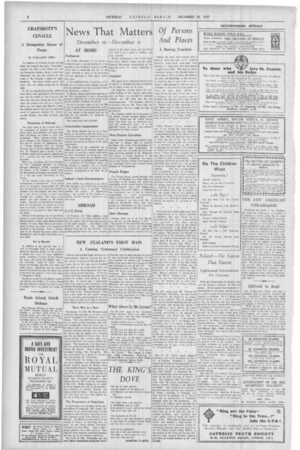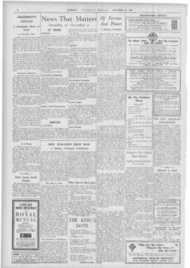Page 2, 23rd December 1937
Page 2

Report an error
Noticed an error on this page?If you've noticed an error in this article please click here to report it.
Tags
Share
Related articles
A Roving Causerie
Of Persons And Places
Of Persons And Places
"his Pen Was Blest"
Of Persons And Places
Of Persons
And Places
A Roving Causerie Among the many who learned with a shock of grief, last week, of Fr. Charles Dawson's tragic death must have been hundreds of retreatants who have passed through Loyola Hall. Who that has made a week-end retreat at the Rainhill house in recent years is likely to forget the welcoming smile and handshake at the entrance, by which he was so soon made to feel at home? And although Fr. Dawson was not prominent in the work of giving public retreats, he gave many private retreats, during the year, in his own room, A retreatant who has frequently been to Rainhill, and who had many opportunities of talking with the worker now dead, recalls Fr. Dawson also in other capacities—as a poet whose muse lit often the pages of the Retreat Journal; as a student of Nature, and a bird-lover : the sparrows would feed from his hand; as " a simple, kindly soul, truly a man after God's own heart."
Father Dawson's literary monument— most of his writing lies swallowed-up in missionary magazines and other ephemera —is the volume entitled The Mirror of Oxford. That work he published more than 25 years ago, and to this day the hook remains the Catholic guide par excellence to the university city—to say this is not to disparage the admirable C.'r.s. pamphlet on Oxford for those who want only a brief survey. Father Dawson, an Exeter College man and a convert, was greatly struck by the need for such an undertaking. Concerning the University he wrote that " much indeed has been written, but it has all been written to harmonise with the Protestant tradition. . . . Now that religious disabilities are removed, and all the privileges r Oxford life are once again open to Catholic students, the time seems opportune for providing Catholic visitors with a story of the University written by a sympathetic hand." The thought had been borne in upon him on returning to his alma muter after a lapse of twenty years. He set himself to the task, helped with his own camera to illustrate the book, and produced a guide and history for which all Catholic lovers of Oxford are debtors in gratitude to his memory.
After upwards of thirty-eight years' work as Administrator of Se Mary's Cathedral at Aberdeen, Mgr. John Meany has relipquished that post. In his seventy-eighth year, and with a loug illness having sapped the strength which he has always given so generously to his duties, this distinguished priest has well-deserved to lighten the burden. The present year brought his golden jubilee in the priesthood, when messages of congratulation reached him from many parts of the world. As a priest of the Aberdeen diocese, Mgr. Meany has served the entire line of Bishops who since the restoration of the Scottish hierarchy in 1878 have ruled that see. He was at the Cathedral with Mgr. John Macdonald, previously Vicar-Apostolic of Scotland's Northern district, and then in turn he saw the episcopal reigns of Mgr. Grant, Mgr. Hugh Macdonald, and Mgr. Chisholm, and he welcomed the present Ordinary, Mgr. Bennett, not far short of twenty years ago. Mgr. Meany's successor as Administrator is Mgr. David Paterson, D.D., already stationed and very well known in Huntly Street. Dr. Paterson was for seven years Vice-Rector of the Scots College in Rome.
For fifty years, now, Mr. Thomas H. Birchall Scott, F.R.I.B.A., has been doing good work for the Church by his profession as an architect. On an average he must have produced something like one new church every year during that period, to say nothing of many schools and other buildings. It is in London and the Home Counties, particularly in the dioceses of Westminster and Brentwood, that Mr. Scott's work is to be seen. In the cemetery at Kensal Green, his is the Belgian War Memorial, and for his interest in Belgium's war-stricken people the architect holds the honour of Chevalier of the Order of Leo
pold. As this note hails a professional jubilee year, it must leave consideration of Mr. Scott's worth at that; but the temptation is strong to add other proofs of active helpfulness by which this veteran worker is prominent year by year in the service of his fellows-in-faith.
One of Mr. Scott's much admired churches is that of St. Lawrence the Martyr at Feltham, Middlesex, a building opened on the feast of the hrunaculate Conception five years ago, when Canon Wood was rector, but only the western half had then been erected. A disastrous fire, it will be recollected. partly destroyed the interior in the early morning of October 4 last. The temporary high altar went, the Lady altar, the pulpit, communion rails, statues, pictures, roofing—a sad spectacle of disaster. Now, however, St. Lawrence's has been restored, and that very beautifully, by Messrs. Fass,nidge, of Uxbridge, and there will be the gladness, for Fr. Bridgman and his parishioners, of Christmas midnight Mass for the re-opening. So quickly is the Feltham parish growing that Cardinal Hinsley has given permission for the restored church to he completed. Two extra bays are to be built, also the permanent sanctuary, apse, sacristies, and other needed works to realise Mc. Scott's plan in full. When this has been done the parish will shoulder a debt burden of something like twelve thousand pounds. St. Lawrence's contains settle very good work by Mr. Philip -Lindsey Clark, D.S.O., in the Stations of the Cross and the font. Fortunately these escaped October's disaster; also there are several windows by Mr. John Trial*
blog comments powered by Disqus

















